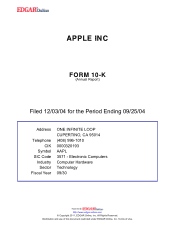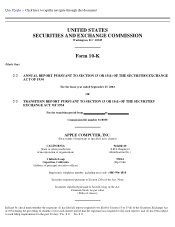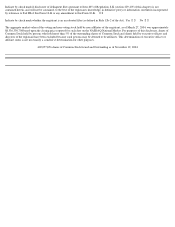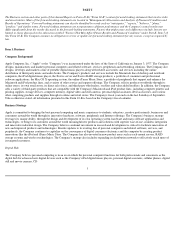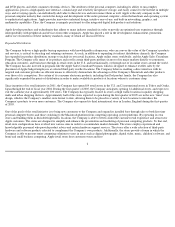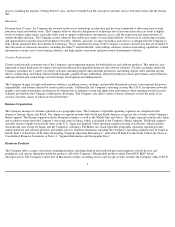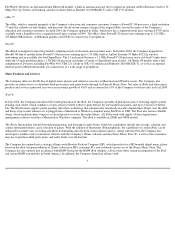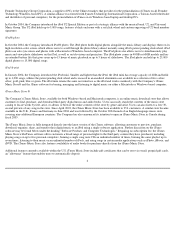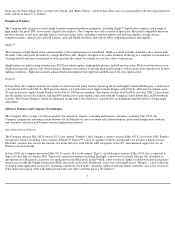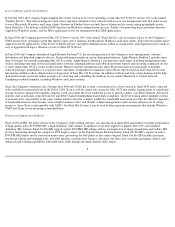Apple 2004 Annual Report Download - page 4
Download and view the complete annual report
Please find page 4 of the 2004 Apple annual report below. You can navigate through the pages in the report by either clicking on the pages listed below, or by using the keyword search tool below to find specific information within the annual report.
PART I
The Business section and other parts of this Annual Report on Form 10-K ("Form 10-K") contain forward-looking statements that involve risks
and uncertainties. Many of the forward-looking statements are located in "Management's Discussion and Analysis of Financial Condition and
Results of Operations." Forward
-looking statements can also be identified by words such as "anticipates," "expects," "believes," "plans,"
"predicts," and similar terms. Forward-looking statements are not guarantees of future performance and the Company's actual results may
differ significantly from the results discussed in the forward-looking statements. Factors that might cause such differences include, but are not
limited to, those discussed in the subsection entitled "Factors That May Affect Future Results and Financial Condition" under Part II, Item 7 of
this Form 10-K. The Company assumes no obligation to revise or update any forward-looking statements for any reason, except as required by
law.
Item 1. Business
Company Background
Apple Computer, Inc. ("Apple" or the "Company") was incorporated under the laws of the State of California on January 3, 1977. The Company
designs, manufactures and markets personal computers and related software, services, peripherals and networking solutions. The Company also
designs, develops and markets a line of portable digital music players along with related accessories and services including the online
distribution of third-party music and audio books. The Company's products and services include the Macintosh line of desktop and notebook
computers, the iPod digital music player, the Xserve server and Xserve RAID storage products, a portfolio of consumer and professional
software applications, the Mac OS X operating system, the online iTunes Music Store, a portfolio of peripherals that support and enhance the
Macintosh and iPod product lines, and a variety of other service and support offerings. The Company sells its products worldwide through its
online stores, its own retail stores, its direct sales force, and third-
party wholesalers, resellers and value added resellers. In addition, the Company
sells a variety of third-party products that are compatible with the Company's Macintosh and iPod product lines, including computer printers and
printing supplies, storage devices, computer memory, digital video and still cameras, personal digital assistants, iPod accessories, and various
other computing products and supplies through its online and retail stores. The Company's fiscal year ends on the last Saturday of September.
Unless otherwise stated, all information presented in this Form 10-K is based on the Company's fiscal calendar.
Business Strategy
Apple is committed to bringing the best personal computing and music experience to students, educators, creative professionals, businesses and
consumers around the world through its innovative hardware, software, peripherals and Internet offerings. The Company's business strategy
leverages its unique ability, through the design and development of its own operating system, hardware and many software applications and
technologies, to bring to its customers around the world meaningful new products and solutions with superior ease-of-use, seamless integration
and innovative industrial design. The Company believes continual investment in research and development is critical to facilitate innovation of
new and improved products and technologies. Besides updates to its existing line of personal computers and related software, services, and
peripherals, the Company continues to capitalize on the convergence of digital consumer electronics and the computer by creating product
innovations like the iPod and iTunes Music Store. The Company has also invested in new product areas such as rack-mount servers, RAID
storage systems and wireless technologies. The Company's strategy also includes expanding its distribution network to effectively reach more of
its targeted customers.
Digital Hub
The Company believes personal computing is in an era in which the personal computer functions for both professionals and consumers as the
digital hub for advanced new digital devices such as the Company's iPod digital music players, personal digital assistants, cellular phones, digital
still and movie cameras, CD
1

